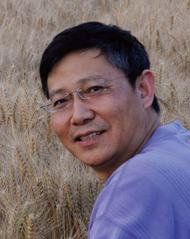Principal investigator
Name:
Xueliang ZhuDistinguished Adjunct Professor from CAS , PhD, Distinguished Adjunct Professor from CAS
Position:
Affiliation:
School of Life Science and Technology, Shanghai Institute of Biochemistry and Cell Biology, CAS
Honor:
Group Introduction
Research Area:
Cell Cycle and Cell Motility
Research Interests:
My group is mainly interested in regulation of cell motilities, including mitosis, migration, and intracellular transport. Such activities often exhibit transient, regional distributions of organelles and/or proteins, require accurate coordination among multiple participants, and involve MT and microfilament cytoskeletons.
We have recently focused on a genetic pathway, the dynein pathway. It was originally identified in Aspergillus in screens for mutants critical for even nuclear distrubutions (Nud) along hyphae and subsequently found to be conserved and essential in mammals. Whereas the majority of Nud genes identified encode subunits of cytoplasmic dynein and dynactin, two genes termed NudE and NudF, corresponding to NudE/NudE-like (Nudel) and Lis1 in mammals, respectively, are of interest because they potentially code for dynein regulators. Moreover, halploinsufficiency of Lis1 is known to cause a severe congenital disease, type I lissencephaly, characterized by smooth brain surface, mental retardation, and short life span. Dynein and dynactin consist of a huge microtubule-dependent molecular motor important for many types of cell motilities. Malfunction of the dynein motor has been shown to cause Amyotrophic lateral sclerosis (ALS), a progressive neurodegenerative disease that affects neurons in the brain and the spinal chord.
Starting from mitosin/CENP-F, an Rb-associated kinetochore protein, we identified NudE and Nudel as its associated proteins. Since then, we have tried to answer how they function in cell motilities in respect to other related proteins.
Representative Publications (*First Author, # Corresponding Author)
- 1. Cao, Jingli*; Shen, Yidong; Zhu, Lei; Xu, Yanan; Zhou, Yizhuo; Wu, Zhili; Li, Yiping; Yan, Xiumin#; Zhu, Xueliang#; .miR-129-3p controls cilia assembly by regulating CP110 and actin dynamics.NATURE CELL BIOLOGY. 2012. 14(7):697-76.
- 2. Xu, Yanan*; Cao, Jingli; Huang, Shan; Feng, Di; Zhang, Wei; Zhu, Xueliang#; Yan, Xiumin; .Characterization of Tetratricopeptide Repeat-Containing Proteins Critical for Cilia Formation and Function.PLOS ONE. 10 Apr 2015. 10(4).
- 3. Zhao, Huijie#*; Chen, Qingxia; Fang, Chuyu; Huang, Qiongping; Zhou, Xueliang; Yan, Xiumin#; Zhu, Xueliang#; .Parental centrioles are dispensable for deuterosome formation and function during basal body amplification.EMBO REPORTS. 04 Mar 2020. 20(4).
- 4. Shan, Yongli#*; Yu, Lihou; Li, Yan; Pan, Youdong; Zhang, Qiangge; Wang, Fubin; Chen, Jianfeng; Zhu, Xueliang#; .Nudel and FAK as Antagonizing Strength Modulators of Nascent Adhesions through Paxillin.PLOS BIOLOGY. 2009. 7(5).
- 5. Ma, Li*; Tsai, Ming-Ying; Wang, Shusheng; Lu, Bingwen; Chen, Rong; Yates, John R., III; Zhu, Xueliang#; Zheng, Yixian#; .Requirement for Nudel and dynein for assembly of the lamin B spindle matrix.NATURE CELL BIOLOGY. 2009. 11(3):246.
- 6. Shen, Yidong*; Li, Ning; Wu, Shuang; Zhou, Yizhuo; Shan, Yongli; Zhang, Qiangge; Ding, Chong; Yuan, Quan; Zhao, Fukun; Zeng, Rong; Zhu, Xueliang#; .Nudel binds Cdc42GAP to modulate Cdc42 activity at the leading edge of migrating cells.DEVELOPMENTAL CELL. 2008. 14(3):342-353.
- 7. Zeng, Liyong*; Cai, Cheguo; Li, Shan; Wang, Wenjuan; Li, Yaping; Chen, Jiangye; Zhu, Xueliang#; Zeng, Yi Arial#; .Essential Roles of Cyclin Y-Like 1 and Cyclin Y in Dividing Wnt-Responsive Mammary Stem/Progenitor Cells.PLOS GENETICS. May 2016. 12(5).
- 8. Zhang, Qiangge*; Wang, Fubin; Cao, Jingli; Shen, Yidong; Huang, Qiongping; Bao, Lan; Zhu, Xueliang#; .Nudel Promotes Axonal Lysosome Clearance and Endo-lysosome Formation via Dynein-Mediated Transport.TRAFFIC. 2009. 10(9):1337-1349.
|



